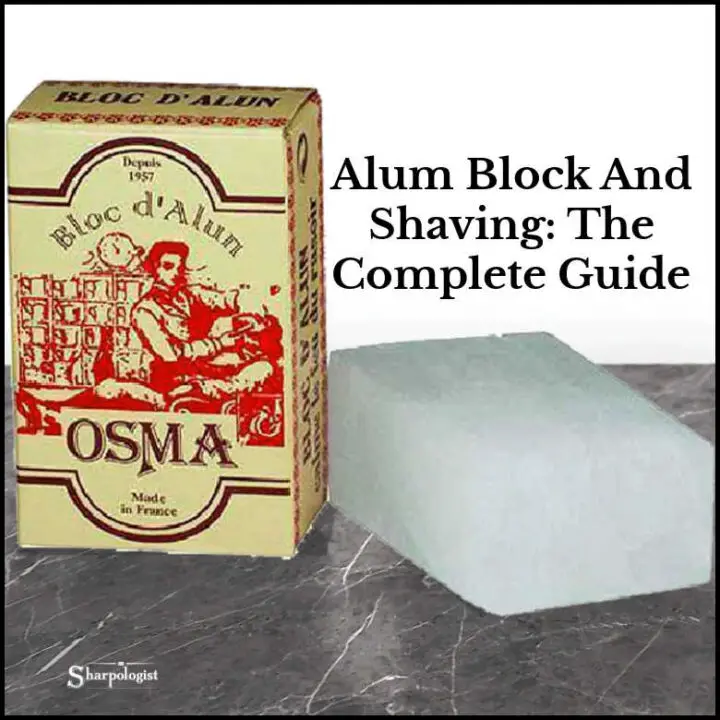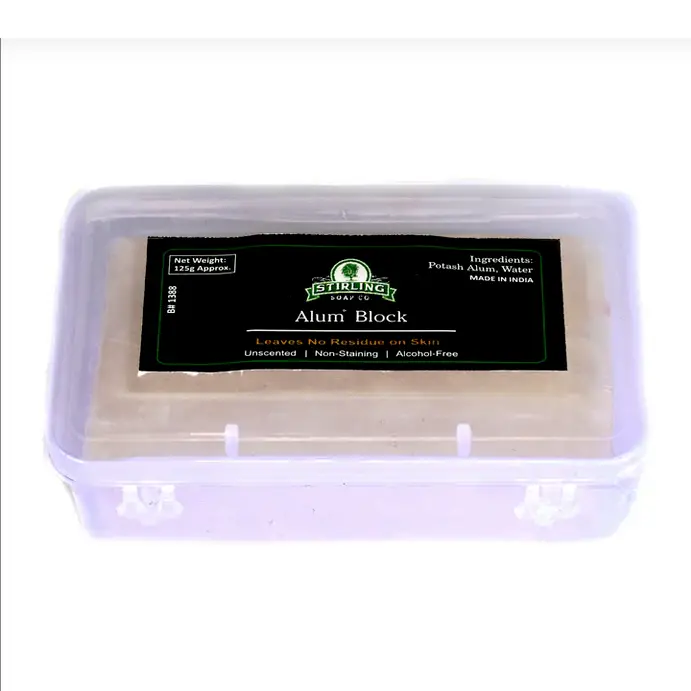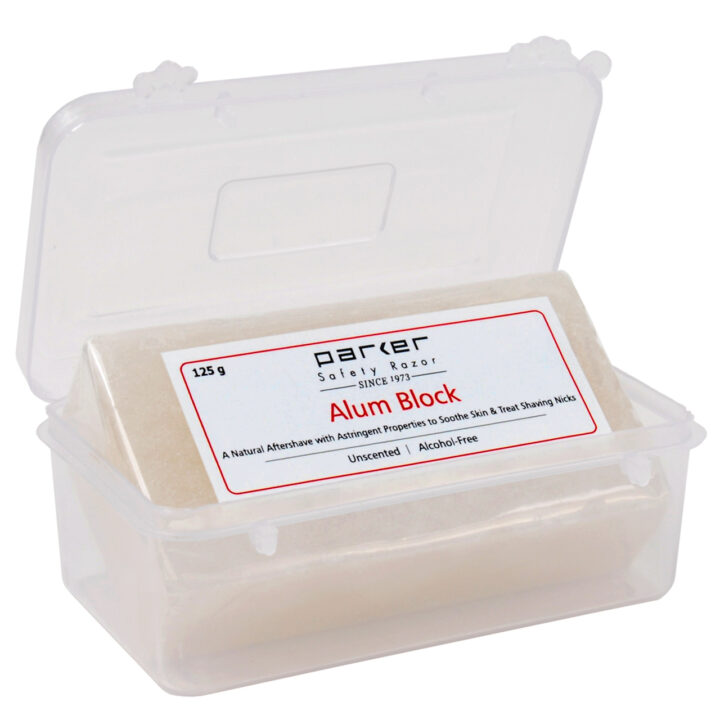
Image courtesy of New England Shaving Co.
An alum block is a natural mineral that is used as a post-shave treatment. It helps to close small cuts, reduce inflammation, and soothe the skin.
What Is Alum Block?
An alum block is a naturally occurring mineral stone composed of potassium alum, also known as alum. The main component of alum is calcium aluminates. It is a composite of calcium, aluminum, and oxygen. The mineral is found in many places around the world.
Potassium alum can also be produced industrially by adding potassium sulfate to a concentrated solution of aluminium sulfate. The aluminium sulfate is usually obtained by treating minerals like alum schist, bauxite, or cryolite with sulfuric acid.
Alum Block History
Potassium alum Alum also has a long history of use as a mineral and composite. It was first known as a useful mineral more than 3500 years ago and understood for “medicinal” purposes (for its antiseptic and healing properties) more than 2000 years ago.
Medicinally it was understood to cool and revitalize the skin, reduce the appearance of skin imperfections, and to treat dermatological concerns such as acne, blackheads, clogged pores, and oily skin. Alum is also used to help reduce the appearance of scars.
Potassium alum has been used in the treatment of eye problems, burns, and cuts. It has also been used in the production of toothpaste and mouthwashes.
The Benefits Of Alum Block In Shaving
Alum blocks have been around for centuries and are still one of the best ways to finish your shave by helping to stop minor bleeding, inflammation, and redness
Potassium alum can also prevent bacteria from infecting your pores which can cause razor bumps.

Image courtesy of Stirling Soap Co.
Alum Block Information: Health Risks And Precautions
Alum blocks contain aluminum sulfate, which can cause skin irritation and rashes in some people. In addition, alum can also dry out your skin, so it’s important to use a moisturizer after shaving if you’re going to use an alum block.
Alum block is effective for all skin types
If you are suffering from an allergic reaction, you may want to avoid applying an Alum block.
If you have any concerns about using an alum block, consult your doctor before using one.
How To Use An Alum Block On The Skin
An alum block is a natural deodorant and antiseptic that can be used to cleanse and close the skin after shaving. It can also be used to treat razor burn and minor nicks and cuts.
Before use, soak the block in cool water for a cooling sensation that could reduce nicks and cuts from shaving or razor burn.
The alum block is to be massaged gently across the areas of your neck and face that you shaved. If you have shaved “properly,” with no nicks or cuts, you will probably feel a refreshing, cooling sensation. If you have ‘overshaved’ or have a nick the astringent qualities an alum block may cause some mild tightness and tingling or burning sensations–but this is expected because it’s just the alum block working its magic.
After massaging on, let the crystals dry on your skin for about 15 to 20 seconds. After rinsing off the residue, moisturize your skin and apply an aftershave product as needed such as a high-quality moisturizer or aftershave balm.
Other Uses For Alum Block Products
An alum block is not just for finishing your shave- it has many other uses, as well. For example, alum blocks are great for people with oily skin, as they help reduce shine and protect the skin from bacteria. In addition, they can be used to treat spots and blackheads.
Alum Block And Acne
Alum block can help treat acne by tightening the skin and killing bacteria. When used regularly, alum block can help keep your pores clear and free from acne-causing bacteria.
Alum Stone As A Natural Deodorant
It is available in crystal form and can be found at many drugstores. To use, wet the alum block, rub it on your armpits, and allow it to dry. The alum will kill the bacteria that causes odor and leave your pits feeling refreshed and clean. Alum blocks can help reduce razor bumps and ingrown hairs after shaving the underarms.
If you’re looking for an all-natural alternative to commercial deodorants, alum is definitely worth a try!
How To Store An Alum Block

Image courtesy of Super Safety Razors
Alum blocks can be stored in a cool, dry place, such as a medicine cabinet.
When you’re not using it, it’s best to store your alum block in a cool, dry place. Some people like to keep them in the fridge. Others recommend wrapping them in clingfilm (Saran Wrap) or storing them in a zip-lock bag. Personally, I just put mine on the windowsill where it gets good light but isn’t too hot or cold.
How you store your alum block is really up to you – there is no one “correct” way to do it!
Alum Block vs. Styptic Pencil
Both alum blocks and styptic pencils are made from the same compound. However a styptic pencil is more concentrated. The astringent properties of alum blocks and styptic pencils help to close minor nicks and cuts.
However, while both products can be useful in your shaving routine, there are some differences in what they can do and how they do it:
- Alum blocks are usually better for minor nicks that may happen during shaving. They can also be used as a natural deodorant, or as a part of a skin care routine to reduce acne. The mineral in block form has a longer shelf life.
- Styptic pencils are usually reserved for more serious cuts. Styptic pencils aren’t just used for shaving–they are also useful against most types of minor bleeding. The powder pencil form may be used up more quickly than an alum block.
Related post: click/tap here for Shaving 101: Styptic Pencils–What They Are, What They Do, How To Use Them, And How To Shop For One
Summing Up
Using an alum block after shaving is a great way to temporarily tighten the skin, reduce inflammation, and help prevent razor burn. It’s a natural and affordable way to take care of your skin after shaving.
Alum block is available from many sources (click/tap here for a short list for example).

Since I am traveling about 35 weeks/year I prefer the small cylinders of alum with a plastic screw lid. RazoRock sells them branded as such and are frequently discounted. Same thing sometime smaller sold in drugstores, groceries (eg Kroger), and Amazon as “natural deodorant” sticks. I like one that also says it contains aloe even though I’m a bit skeptical of that. Every brand I’ve ever seen of these come from Thailand. Just something I’ve noticed. I use one of these small self contained alum sticks almost always as first step after cold water rinse post-shave.
Is there a difference between an alum block and the crystal alum sold as a deodorant? Or can either perform double duty?
Deodorant alum is often (but not always) ammonium alum instead of potassium alum. Ammonium alum stings more. It should say on the container which alum is used. If it’s potassium alum, it works fine for shaving.
I use the septic stick and it works like a charm on nicks.
Alum blocks are also useful for traveling to motels with very soft water. I usually move it to the shower area since I don’t like the oily feeling after washing. With soft water, it never feels like I get all the soap off. Rubbing my hands on the block immediately allows me to get that “squeaky” clean feeling. Hard to describe, hope that makes sense.
They’re also good for shaving of course!
The squeaky feeling after a hard-water shower is from soap scum stuck to your skin. (The scum forms from the interaction between the calcium in hard water and the soap.)
In soft water, the soap is immediately rinsed off, and the slick feeling is just the natural feeling of wet clean skin. It’s not due to the soap (which is gone after being rinsed), it’s due to clean skin being slick when wet.
I grew up in a hard-water area and my immediate reaction to soft water was the same as yours, but after I understood that clean skin is slick when wet, and that the “squeaky clean” is the feeling when soap scum clings to the skin, I started liking soft water.
Thank you for explaining that. I always thought it was the opposite. I grew up with very hard water. In fact, my parent’s plumbing barely runs after 40 years of calcification. Since I always thought that was normal water I’ve always dreaded soft water because of that slick feeling. I appreciate you taking the time to respond. I will try it without the alum next time.
And thank you for your book. It makes a great gift to new shavers who are just getting into the “hobby” and it is always well received.
Justin, you made my day. Thank you very much for your kind remarks.
I just gave a shaving kit to a guy yesterday who had no knowledge of this sort of thing. When he saw my collection of razors, he said, “Wow! I’ve never used a straight razor!” 🙂
So I gave him a full kit — a Yaqi synthetic brush, a soap, the superb Baili Victor (BR171), which is sold under various names, some blades, and an aftershave, and I went over good technique, mentioning lathering before each pass and keeping the handle of the razor away from the face (unlike with cartridge razors).
I saw him this morning, and he said it was the best shave he’s had.
From the Guide, another use for alum blocks. Quote:
The alum block has multiple uses. One woman notes that the alum block seems to take care of pimples—she just washes her face with water and then glides the alum block over her wet face and follows that with Thayers Rose Petal Witch Hazel. The result: no pimples, and no residual powder from the alum block. (She reports that it also stops the stinging on bug bites.) Also, those with skin blemishes may want to use the alum block even on non-shave days.
/endquote
The Guide also points out that potash (potassium) alum is preferable to ammonium alum because the latter stings more. Most alum blocks do use potassium alum for this very reason, but I have seen ammonium alum around.
Keeping the alum block in the refrigerator or freezer makes for a nice aftershave experience on a hot summer morning.
Great article. I use an alum block after every shave. It’s probably the only “constant” in my ever-changing daily shave.
I think I am slightly allergic to alum block. If I leave it on for more than 10-15 seconds. I get redness. So, I apply rinse quickly. I dry the block, and set so it gets air circulation.
Comments are closed.